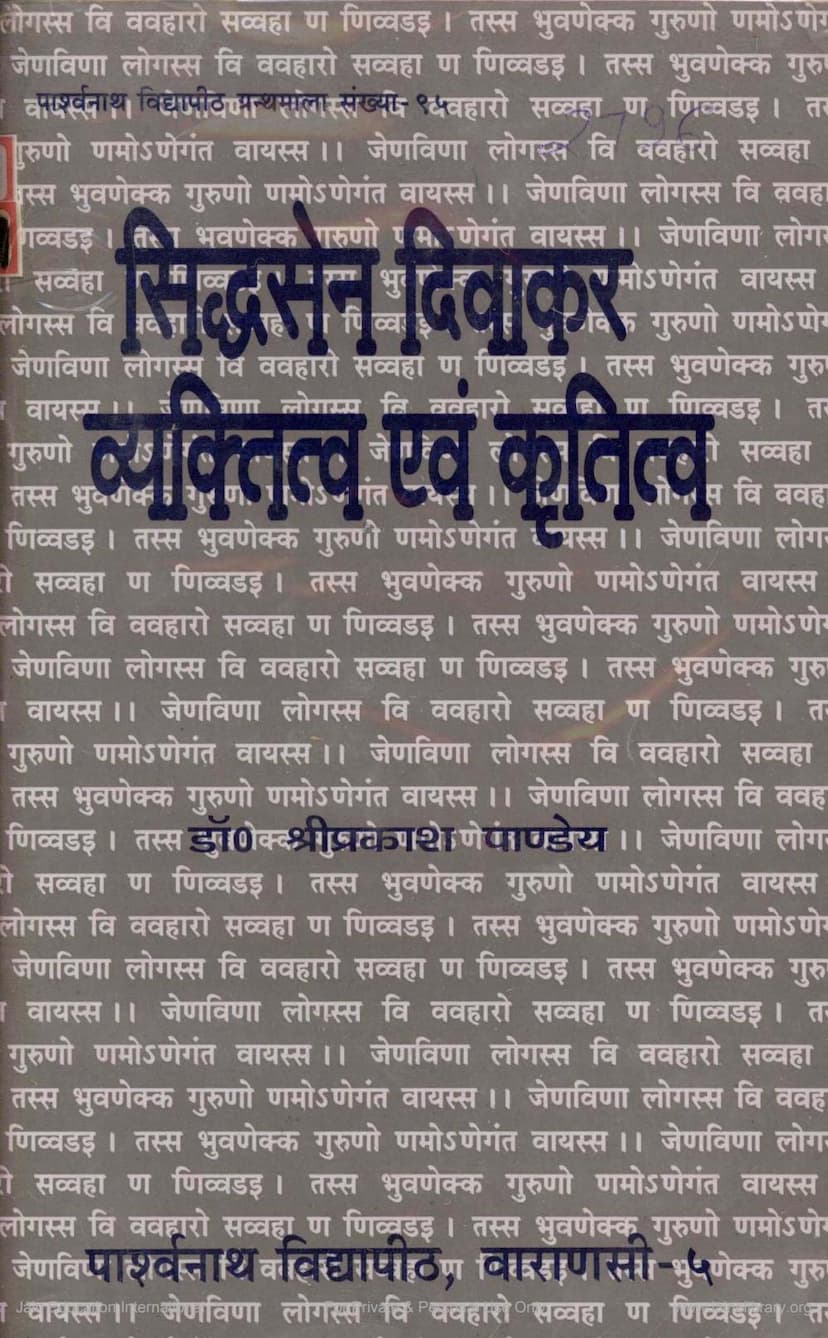Siddhsen Diwakar Vyaktitva Evam Krutitva
Added to library: September 2, 2025

Summary
Here's a comprehensive summary of the Jain text "Siddhasena Diwakara: Vyaktitva evam Krtitva" by Shreeprakash Pandey, based on the provided pages:
Book Title: Siddhhasena Diwakara: Vyaktitva evam Krtitva (Siddhasena Diwakara: Personality and Works) Author: Dr. Shreeprakash Pandey Publisher: Parshvanath Shodhpith Varanasi Year of Publication: 1997
Overall Purpose: This book is a scholarly exploration of the life, personality, and literary contributions of Acharya Siddhasena Diwakara, a prominent figure in Jain philosophy and literature. The author, Dr. Shreeprakash Pandey, aims to provide a comprehensive and critical analysis of Siddhasena Diwakara's works, his historical context, and the scholarly debates surrounding them.
Key Themes and Content:
-
Revisiting Scholarly Debates: The book addresses the ongoing scholarly discussions and differing opinions regarding Siddhasena Diwakara's lifespan, his sectarian affiliation (Śvetāmbara, Digambara, or Yāpanīya), and the authorship of his major works. Modern scholars have raised questions about whether works like Sanmatitarka, Nyāyāvatāra, Dvātriṁśadvātriṁśikā, and Kalyāṇamandira Stotra are indeed by Siddhasena Diwakara or by other scholars of the same name.
-
Establishment of Siddhasena Diwakara's Period (Samaya):
- Chapter 1 is dedicated to establishing Siddhasena Diwakara's historical period. It examines various literary sources, inscriptions, and the opinions of ancient and modern scholars to determine his exact timeframe.
- The book discusses the challenges in pinpointing his exact period due to the existence of multiple individuals named Siddhasena in Jain tradition.
- It critically analyzes the historical evidence, including references in works by Haribhadra Suri, Jinadāsagaṇi Mahattara (Nishītha Chūrṇi), and Pujyapāda Devanandi (Jainendra Vyākaraṇa).
- The author engages with the arguments of prominent scholars like Pandit Sukh Lal, Professor A.N. Upadhye, Pandit Jugal Kishore Mukhtar, and Professor M.A. Dhaky, often presenting a nuanced perspective or proposing an alternative interpretation.
- Ultimately, based on the available evidence, the book places Siddhasena Diwakara predominantly in the 5th Century CE, aligning with figures like Chandragupta II Vikramaditya and refuting later dating.
-
Siddhasena Diwakara's Personality and Life:
- Chapter 2 delves into Siddhasena Diwakara's personality and biographical details.
- It acknowledges the scarcity of direct autobiographical information, relying primarily on Puranic (Prabandha) literature for accounts of his life.
- The book recounts popular narratives from the Prabandhas, such as his intellectual prowess, his debate with Vriddhivādī (leading to his initiation into Jainism), his epithet "Diwakara" (Sun) for dispelling ignorance, his miraculous abilities (like the "Sarsapa Vidya" and "Hema Vidya"), and his eventual reconciliation with his guru, Vriddhivādī.
- It also touches upon the legend of his temporary excommunication from the monastic order due to his desire to translate Jain Agamas into Sanskrit and his subsequent readmission after performing a miracle at the Mahakala temple in Ujjain.
- The chapter also discusses the differing traditions regarding his place of birth (Ujjain vs. South India/Karnataka) and critically evaluates the arguments supporting each view.
-
Analysis of Siddhasena Diwakara's Works:
- Chapter 3 is a detailed examination of Siddhasena Diwakara's literary corpus.
- Sanmatitarka (Sanmati Sutra): This is considered his most definitive work. The book highlights its significance as a foundational text in Jain logic and epistemology, particularly for its systematic exposition of Anekāntavāda (the doctrine of manifold aspects). It discusses the structure, language (Mahārāṣṭrī Prākṛt), philosophical arguments, and the commentaries written on it.
- Dvātriṁśadvātriṁśikā (Thirty-two by thirty-two): The book addresses the collection of 32 works, each consisting of 32 verses. It discusses the content, language (Sanskrit), and authorship debates surrounding these works. The author explores the possibility that not all of them are by the same Siddhasena Diwakara, with some potentially attributed to later individuals.
- Nyāyāvatāra: This work, often considered a treatise on Jain logic and epistemology, is a major point of scholarly contention. The book meticulously reviews the arguments for and against Siddhasena Diwakara's authorship, comparing it with the works of Dignāga, Dharmakīrti, and other Buddhist logicians, as well as with the views of Indian scholars like Pandit Sukh Lal, Professor Upadhye, Pandit Mukhtar, and Professor Dhaky. Ultimately, the author leans towards the conclusion that Nyāyāvatāra might be the work of Siddharshi, a later commentator, or there is significant confusion regarding its authorship.
- Kalyāṇamandira Stotra: This devotional hymn is also discussed, with a focus on its authorship and its legendary connection to Siddhasena Diwakara's life story. The book critically examines the claim that the author of the hymn, Kumudachandra (mentioned in some Prabandhas as Siddhasena's initiation name), is indeed Siddhasena Diwakara. It also explores the similarities with the Bhaktāmara Stotra by Manatunga and suggests that the Kalyāṇamandira Stotra might be a later composition, possibly by a different Kumudachandra, and not by Siddhasena Diwakara.
-
Sectarian Affiliation: A significant portion of the book is dedicated to resolving the debate about Siddhasena Diwakara's sectarian identity. It examines the references in Śvetāmbara, Digambara, and Yāpanīya literature, analyzing the arguments presented by scholars like Mukhtar and Upadhye. The author concludes that Siddhasena Diwakara predates the formal establishment of distinct Śvetāmbara and Digambara sects and likely belonged to an earlier, unified Jain tradition that later branched out. He was revered by both Śvetāmbara and Yāpanīya traditions, possibly due to his critiques of certain Śvetāmbara viewpoints, but his direct affiliation is complex and predates sectarian divisions.
Methodology and Scholarly Approach: Dr. Shreeprakash Pandey employs a rigorous scholarly approach, critically examining ancient texts, historical records, and the diverse interpretations of previous scholars. The book is characterized by its detailed referencing, comparative analysis of different traditions, and a commitment to establishing historical and philosophical accuracy. The author acknowledges areas of disagreement with established scholars, particularly regarding the authorship of Nyāyāvatāra and the dating of certain texts, showcasing intellectual honesty.
Significance: The book is a valuable contribution to Jain scholarship, offering a detailed and reasoned perspective on one of Jainism's most influential philosophical figures. It aims to clarify the historical context, the true extent of Siddhasena Diwakara's literary output, and his place within the broader landscape of Indian philosophy. It serves as an essential resource for researchers and students of Jainism.